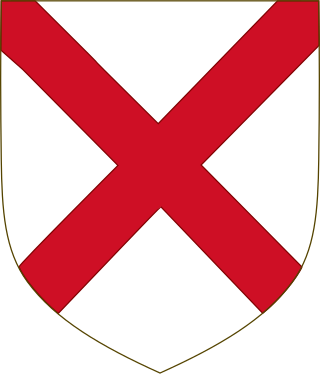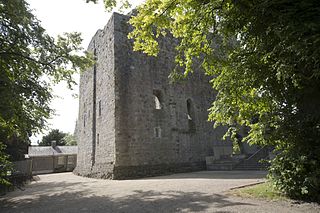Related Research Articles

The FitzGerald dynasty is a Hiberno-Norman noble and aristocratic dynasty, originally of Cambro-Norman and Anglo-Norman origin. They have been peers of Ireland since at least the 13th century, and are described in the Annals of the Four Masters as having become "more Irish than the Irish themselves" or Gaels, due to assimilation with the native Gaelic aristocratic and popular culture. The dynasty has also been referred to as the Geraldines and Ireland's largest landowners. They achieved power through colonisation and the conquest of large swathes of Irish territory by the sons and grandsons of Gerald de Windsor. Gerald de Windsor was the first Castellan of Pembroke Castle in Wales, and became the male progenitor of the FitzMaurice and FitzGerald Dynasty. His father, Baron Walter FitzOther, was the first Constable and Governor of Windsor Castle for William the Conqueror, and was the Lord of 38 manors in England, making the FitzGeralds one of the "service families" on whom the King relied for his survival. Some of its members became the Black Knights, Green Knights and White Knights.

Rowland FitzEustace, 1st Baron Portlester was an Irish peer, statesman and judge. He was one of the dominant political figures in late fifteenth-century Ireland, rivalled in influence probably only by his son-in-law Garret FitzGerald, the "Great" Earl of Kildare.

Maurice FitzThomas FitzGerald, 1st Earl of Desmond in Dublin Castle, Dublin, Ireland was an Irish nobleman in the Peerage of Ireland, Captain of Desmond Castle in Kinsale, so-called ruler of Munster, and for a short time Lord Justice of Ireland. Called "Maurice the Great", he led a rebellion against the Crown, but he was ultimately restored to favour.
James Butler, 4th Earl of Ormond was the son of James Butler, 3rd Earl of Ormond. He was called 'The White Earl', and was esteemed for his learning. He was the patron of the Irish literary work, 'The Book of the White Earl'. His career was marked by his long and bitter feud with the Talbot family.
James Butler, 1st Earl of Ormond, was a noble in the Peerage of Ireland. He was born in Arklow, Wicklow, Ireland and died in Gowran, Kilkenny, Ireland.
John FitzThomas was an Anglo-Norman in the Peerage of Ireland, as 4th Lord of Offaly from 1287 and subsequently as 1st Earl of Kildare from 1316.
Maurice FitzThomas FitzGerald, 4th Earl of Kildare was a prominent Irish nobleman in the Peerage of Ireland who held the office of Lord Justice of Ireland.
Elizabeth Butler, Countess of Ormond, was the wife of Irish peer James Butler, 2nd Earl of Ormond, and the mother of his six children, including James Butler, 3rd Earl of Ormond.

Thomas FitzJohn FitzGerald, 7th Earl of Kildare, was an Irish peer and statesman of the fifteenth century who held the office of Lord Chancellor of Ireland.
Maurice FitzMaurice FitzGerald was an Irish magnate, soldier, and Justiciar of Ireland from 1272 to 1273. His family would come to epitomise the ideal of cultural synthesis in Ireland, becoming "more Irish than the Irish themselves", fusing Gaelic and Norman customs in Irish identity. "But others say he never enjoyed that lordship himself, but that it passed to the son and grandson of his eldest brother Gerald."

Richard Óg de Burgh, 2nd Earl of Ulster and 3rd Baron of Connaught, called The Red Earl, was one of the most powerful Irish nobles of the late 13th and early 14th centuries and father of Elizabeth, wife of King Robert the Bruce of Scotland.
Sir Thomas FitzGerald of Laccagh (c.1458–1487) was an Irish lawyer, statesman and soldier who was Lord Chancellor of Ireland under Richard III and Henry VII, but rebelled against Henry and was killed at the Battle of Stoke.
Sir William Welles was an English-born statesman and judge in fifteenth-century Ireland, who held the office of Lord Chancellor of Ireland. He was the younger brother of Lionel de Welles, 6th Baron Welles. Lionel was a prominent supporter of the House of Lancaster, who was killed at the Battle of Towton on 29 March 1461.
Robert Preston, 1st Viscount Gormanston (1435–1503) was an Irish peer and statesman of the fifteenth century who held the offices of Deputy to the Lord Chancellor of Ireland and Lord Deputy of Ireland.
Thomas Le Boteller, or Thomas Butler, nicknamed Thomas Bacach i.e. Thomas the Lame, was the illegitimate son of the 3rd Earl of Ormond, and a leading political figure in early fifteenth-century Ireland. He held the offices of Lord Chancellor of Ireland, Lord Deputy of Ireland and Prior of Kilmainham. In his own lifetime, he was a highly unpopular statesman, who was accused by his numerous enemies of treason. He is now chiefly remembered as a professional soldier, who was present at the Siege of Rouen in 1418–19. He had previously fought in the sanguinary conflict known as the Battle of Bloody Bank near Dublin in 1402.

James fitz John FitzGerald, 13th Earl of Desmond, also counted as the 14th, ruled 22 years, the first 4 years as de facto earl until the death of James FitzGerald, de jure 12th Earl of Desmond, called Court Page, who was murdered by James fitz John's brother Maurice fitz John FitzGerald, called Totane. James fitz John FitzGerald maintained himself in power by skilful diplomacy, avoiding armed conflict and destruction. He was appointed Lord Treasurer of Ireland in 1547.

Gerald FitzGerald, 8th Earl of Kildare, known variously as "Garret the Great" or "The Great Earl", was Ireland's premier peer. He served as Lord Deputy of Ireland from 1477 to 1494, and from 1496 onward. His power was so great that he was called "the uncrowned King of Ireland".
Giles Thorndon was a senior official of the English Crown in the fifteenth century, who was noted for his long and loyal service to the House of Lancaster and for his troubled and unsuccessful career as Lord Treasurer of Ireland.
Christopher Preston, 2nd Baron Gormanston was an Anglo-Irish peer and statesman. He was accused of treason and imprisoned in 1418-19, but was soon released and restored to royal favour.
References
- ↑ FitzGerald, Walter. "The FitzGeralds of Ballyshannon", Journal of the Co. Kildare Archaeological Society and Surrounding Districts, Vol. 3, County Kildare Archaeological Society, 1902, p. 427
- ↑ Otway-Ruthven, A.J. History of Medieval Ireland Barnes and Noble reissue 1993
- ↑ Webb, Alfred. "Fitzgerald, Gerald, 5th Earl of Kildare", A Compendium of Irish Biography, M.H. Gill & Son, Dublin, 1878
- ↑ Otway-Ruthven